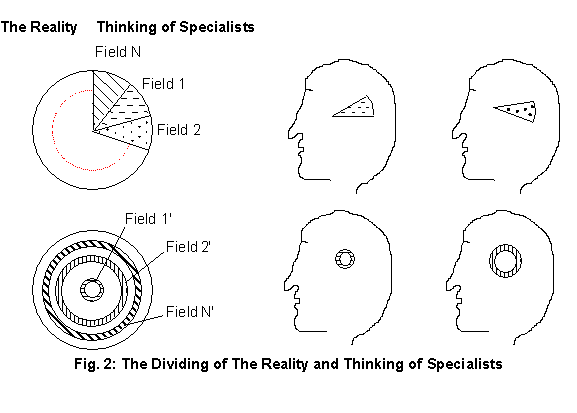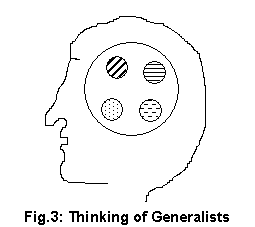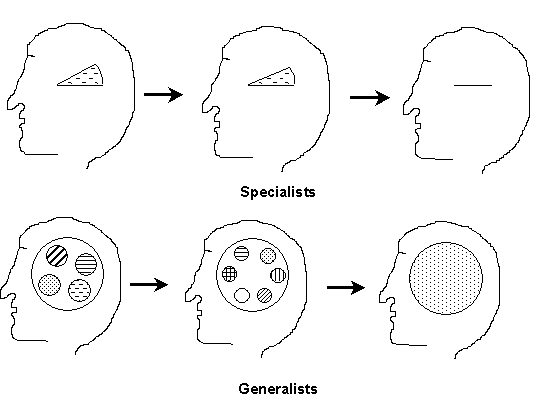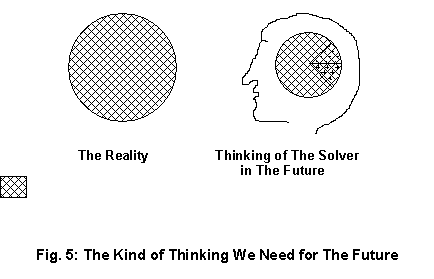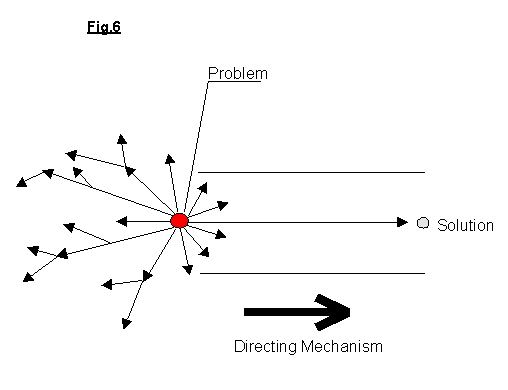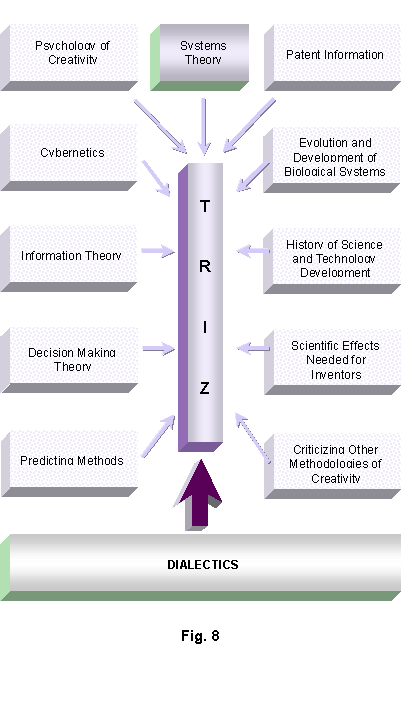 TRIZ
Papers
TRIZ
Papers |
  
|
| Dialectical
Systems Thinking for Problem Solving and Decision Making |
Phan Dung
(CSTC,
Vietnam National Univ. - Hochiminh City)
7th Intern'l Conf. on Thinking, June 1-6, 1997, Singapore |
Short preface
by the Editor (T. Nakagawa) (Jul. 8, 1999):
This paper was posted here on the request of the author as the copyright
holder.
See the TRIZ Forum page
on the author's activities in Vietnam and communications with the Editor.
A basic program of Creativity Methodologies
(i.e. 60 hour course on TRIZ) taught by the author in Vietnam is also
posted here.
"DIALECTICAL SYSTEMS THINKING
FOR PROBLEM SOLVING AND DECISION MAKING"
A Paper for
THE 7TH INTERNATIONAL CONFERENCE ON THINKING
Singapore International Convention and Exhibition
Centre
June 1-6, 1997
Hosted by National Institute of Education
Nanyang Technological University, Singapore
by
PHAN DUNG
Doctor of Philosophy, Doctor of Science, Director
of the Center for Scientific and Technical Creativity, College of Natural
Sciences, Vietnam National University - HoChiMinh City
227 Nguyen Van Cu St., Dist. 5., HoChiMinh City,
Vietnam.
Tel: (848) 8 301 743.
Fax: (848) 8 354 009.
E-mail:pdung@hcmuns.edu.vn
DIALECTICAL SYSTEMS THINKING
FOR PROBLEM SOLVING AND DECISION MAKING
Phan Dung
ABSTRACT : One of the
definitions of human life is as follows : "Life is a chain of problems
to be solved and decisions to be made".
Problems can occur to any person
at any time and in any place. Unfortunately, our present educational and
training system mainly prepares specialists. As a result of that, these
specialists having such narrow thinking may successfully solve their specialized
problems but may not know how to solve other problems. Life will be happy
if all problems in general can be solved well. In the opposite case life
will be "the sea of torments".
The author of this paper argues that
the kind of thinking we need for problem solving and decision making in
any case should rely on the most generalized knowledge, isomorphic, similar
or analogical properties and conclusions that are applicable to all or
almost all areas of practice. In other words, this paper presents the kind
of thinking based on dialectical laws, the results of systems research
and some important concepts derived from different sciences such as informatics,
cybernetics... This kind of thinking has been realized in TRIZ (Russian
acronym for Theory of Inventive Problem Solving) and has recently extended
its applications to other non-engineering fields. Having been working for
nearly 25 years in the field of creativity and innovation, the author believes
that such a kind of thinking will make a significant contribution to developing
productive and effective thinking tools for all people. In this paper,
the author also shares some of his experience in teaching this kind of
thinking at the Center for Scientific and Technical Creativity (CSTC) belonging
to Vietnam National University - HoChiMinh City.
I. INTRODUCTION
There are three areas: nature, society
and thinking that should be understood and transformed by mankind in order
to meet its needs during its history of evolution and development. Unfortunately,
among them, thinking had received the least attention until recently. This
situation has caused a great number of tragedies at personal, group, national,
and even global levels.
Our present educational and training
system mainly prepares specialists. As a result of that, these specialists
having such a narrow thinking may successfully solve their specialized
problems but may not know how to think to solve other problems. Life will
be happy if problems in general can be solved well. Using a problem approach,
this paper will consider some points associated with how to improve thinking
for everyone.
A brief personal view of thinking
and related issues will be presented in the second part of this paper.
The third part will outline main ideas of TRIZ (Russian acronym for Theory
of Inventive Problem Solving - TIPS) which can be named as inventive creativity
based on the laws of dialectics and systems development. The author will
share some of his experience in teaching creativity methodologies in Vietnam
for last 20 years as well as the results achieved so far. A few conclusions
and visions will be given in the last part of the paper.
II. A PERSONAL VIEW OF THINKING
AND RELATED ISSUES.
-
Usually, human activities originate
from his (her) needs. Besides individual needs, there also exist the needs
of a whole group or community or society.
-
In search of ways how to meet their
needs, people encounter problems. A problem is a situation where a solver
knows the aim (in the widest meaning) but a) does not know any way to reach
it, or b) does not know the optimum way to reach it among several known
ways to reach it (i.e. decision making process).
Problems can occur anywhere, at any
time and to anybody. They can be classified very differently depending
on chosen criteria.
-
Many studies have shown that our brains
work really actively when we have problems to solve or/and decisions to
make. The thought process leading the solver from not knowing to a)knowing
the way to reach his/her aim or b)knowing the optimum way to reach his/her
aim among several known ways we call creative thinking. Because there are
both newness: from "not knowing" to "knowing" and usefulness: at last the
desired aim is reached (at least, creative for the given solver).
-
In our opinion, a problem can be considered
as successfully solved only when its solution has been accepted stably
and fully by the system "practice" (complete innovation), i.e. when all
acceptors (or nearly all ones), potentially needing to use the given solution
in reality have used it as usual. In other words, what we need is not creativity
for the sake of creativity but for the sake of the problem being solved
successfully in practice, that is, for the sake of "complete innovation".
Only in such case we can have a genuine development in reality.
-
Many studies have shown that the most
popular method for problem solving is the trial and error method, that
is, problems have been solved by reviewing widely differing variants and
most of them failed. See Fig.1.
The trial and error method is quite
suited to problems having a small number of possible trials. However, for
problems having a great number of possible trials but at the same time
among them only one or several are solutions, this method shows many disadvantages.
-
There are two kinds of problems faced
by mankind during its history of evolution and development: to cognize
and to transform the reality (in the widest meaning). Because of its complication
people could not cognize and transform the whole reality at once, only
one time they had to divide the reality into different specialized fields
based on common properties or/and functions inherent in each field in order
to solve problems easier. Another reason for specialization is socio-economic
one. Society needs such solvers which should be prepared rapidly and economically
in order to get benefits as soon as possible. Thus, the process of specialization
began and became stronger and deeper, and it has contributed to explanation
why our educational and training system mainly prepares specialists, see
Fig.2.
-
Specialization and preparing specialists
had many advantages if the following assumptions would be valid for ever:
-
The reality can be divided into different
fields objectively.
-
Divided fields do not change with a
time
-
Connections and interactions between
divided fields can be neglected
-
The whole can be considered as an arithmetical
sum of components. Then, a specialist can easily and confidently work in
the given field all his/her life.
-
The contemporary challenges faced by
us such as fast change, increasing complexity, diversity and competition,
on the one hand, have shown that the above assumptions have losed their
force. On the other hand, these chalenges have leaded to an increasing
amount of problems (including totally new kinds of problems).
In order to meet partly these challenges,
the educational and training system began preparing generalists having
some knowledge of several fields who may coordinate with specialists and
thus, compensate for specialization's disadvantages in solving cross-disciplinary
problems, see Fig.3.
-
According to the American philosopher
R.B.Perry, a specialist can be defined as a person who knows more and more
with a time about lesser and lesser and at last he/she will become knowing
almost all things about nothing. On the contrary, a generalist is defined
as a person who knows less and less with a time about greater and greater
and at last he/she will become knowing nothing about all things, seeFig.4.
So, in our opinion if the educational
and training system continues preparing specialists and generalists in
traditional way, like before and now, then we cannot cope with future problems
because of the old set of paradigms.
-
In fact, the reality is in unity and
interactions between its components and changes quantitatively and qualitatively
with a time. First of all, thinking, on the one hand, should obey the inherent
universal attributes and development laws of the reality. On the other
hand, thinking should put forward ideas for further cognizing and transforming
the reality which are based on these universal attributes and laws, taking
into account specific points of concrete problems, see Fig.5.
-
If accepting that where both newness
and usefulness exist at the same time, there exists creativity, then creativity
and innovation are associated with development and vice versa. Creativity
and innovation can happen at the place where subjective psychology of human
being is absent. For example, the evolution and development of biological
systems had been creativity and innovation but human psychology did not
take part in this process then.
-
Luckily, in comparison with our ancestors,
now we have a very great amount of information about many kinds of evolution
and development in biology, society, cosmology, scientific and technological
knowledge and so forth. If before, this information to great extent has
been processed fragmentarily in accordance with specialized fields, then
now, we should reprocess the whole information about the reality from angles
of development. In a such way, because of unity of the reality we can reveal
the most generalized laws of development or at least, isomorphic, similar
or analogical laws of development which can serve as an directing mechanism
in creative thinking (thinking for problem solving and decision making).
Thanks to this mechanism the solver can eliminate a considerable number
of barren trials not coinciding with the laws of development, see Fig.6.
-
In the ideal case, if directing
mechanism can be built very exactly the solver can use only one trial leading
to the solution, see Fig.7. The essence of the issue is that only those
people who grasp these objective laws of development and manage the psychology
along them can achieve a high efficiency in creativity and innovation
Below we will present briefly main
ideas of TRIZ ((Russian acronym for Theory of Inventive Problem Solving
- TIPS) which has been built on the basis of dialectics as philosophy of
development and laws of systems development.
III. TRIZ (TIPS)
TRIZ was created by Genrik Saulovich
Altshuller in the Soviet Union (now CIS), starting in 1946. The following
figure illustrates the sources, on which TRIZ has been constructed.
Dialectics, in our view, is the science
of the most common laws of natural, social and mental development. Creativity
is associated with a development, so TRIZ has selected dialectical laws
as its philosophic foundation. Development from the viewpoint of dialectics,
can be understood as follows:
Supposing at first the system was
at some level of development where there was unity of opposites. This unity
does not exist for ever. Because of a struggle (interaction) between the
contrary sides, the initial unity is broken and a contradiction arises.
The contradiction is resolved so that the system turns to a new level of
development (new unity). In the long run, another contradiction will emerge
and will be resolved again so that the system will turn to a newer level
of development... and so on without ending. Western readers may be interested
to learn that there is some similarity between dialectics and the Taoist
philosophy of the Orient.
TRIZ identifies three kinds of contradiction
in problem solving process: 1)Administrative, 2)Technical and 3) Physical
contradiction. In fact, to solve a problem is to reveal and to resolve
these contradictions.
Mankind has to study objects and
solve problems that are getting more and more complex. It is necessary
to have an approach that permits study not only the components and the
dependences, actions and influences between them, but also the qualitative
change of the whole in relation to these components. Creativity in general
and inventive creativity in particular are very complicated concepts. For
that reason the systems approach is consistently used in TRIZ. Another
advantage of systems research is to help researchers in revealing isomorphic,
analogical properties, conclusions, even laws between systems belonging
differing fields.
Although creativity appears in all
fields of human activities, inventiveness may be, the only field where
patent information (information on inventions) containing creativity information
is structured in special patterns, classified for easily searching and
stored concentratedly, completely, particularly and truly. These characteristics
of patent information facilitate research work in order to reveal the objective
development laws of technical systems which produce inventions, in order
to build techniques (principles), methods, methodology, theory in inventive
creativity.
In reality, TRIZ has been formed
on the basis of careful analysis of over 1.5 million patents and fundamental
inventions taken from technological fields all over the world, taking the
similarities on development between these fields and other fields, (for
example biology, scientific and technological knowledge) into account.
TRIZ takes into account present psychology,
but from its viewpoint human psychology has concretely historical character
and is not unchangeable. Thus, TRIZ also has the purpose of reconstructing
the old psychology and creating a new psychology which will work in accordance
with systems thinking, directed by objective development laws.
TRIZ structure is shown on fig.9.
The objective laws of development
of technical systems serve as the base of TRIZ. At the present eight such
laws have been found. In the future the number may increase.
In TRIZ there is a technique called
substance-field analysis (vepol analysis in Russian) which helps the solver
to differentiate familiar (standard) and unfamiliar (non standard) problems.
The standard problem concept has the meaning only for one who learned TRIZ.
Then, the solver can use standard rules from information store for solving
inventive standard problems. For the time being there is a system of 76
standard rules in TRIZ.
In order to grasp TRIZ the participant
in the studying process must solve hundreds of instructional problems,
taken from patent information. The solutions to these problems factually
become the participant's "capital" which can be used in reality when he
(or she) meets analogous problems.
The information store of TRIZ includes
a knowledge-base which collects strong scientific effects often found in
the field of inventive creativity and for making inventions at higher creativity
levels. Presently, TRIZ has selected 50 geometrical, over 100 chemical,
over 300 physical and a few biological effects.
The information store of TRIZ also
contains the system of techniques helping the solver to overcome technical
and physical contradictions. The system involves 40 basic principles and
11 transformers.
If the given problem is not standard
(unfamiliar), then the solver should use ARIZ (Algorithm of Inventive Problem
Solving). ARIZ is a logical, directed and planned programme composed of
many steps which aims at rationally organizing the process of inventive
problem solving. ARIZ is an algorithm for human being so ARIZfs steps
were built not only on the basis of objective laws of evolution and development
of technical systems, but also considering the elements of psychology and
imagination. ARIZ is directly supported by the information store of TRIZ
In July 1989 an International TRIZ
Association was formed in the former Soviet Union with its President -
Mr. G.S. Altshuller, and the Journal of TRIZ was issued in 1990.
At present hundreds of corporations
in CIS, former socialist countries, USA, Israel and Finland are actively
using TRIZ, and hundreds of thousands of innovations have been created.
TRIZ is continuing to develop and
is being applied to other areas, such as engineering value analysis used
for improvement of current products and their cost reduction, process improvement,
management, economics, research, science, failure prediction, education
(especially in educating children to think creatively). Inventing machine
systems, created through combining TRIZ and personal computing won the
golden medal at the world exhibition EXPO'90 organised by UNIDO. In recent
years, there have been some new studies aiming at constructing greater
theories based on TRIZ such as the Theory of Development of Technical Systems
(Russian acronym TRTS); a General Theory of Strong Thinking (OTSM) and
a Theory of Development of Creative Personalities (TRTL).
IV. INTRODUCING CREATIVITY METHODOLOGIES
INTO VIETNAM
After I graduated from the Soviet
academic and research Institute of Inventive Creativity in 1973, with encouragement
of Mr. G.S.Altshuller and the experiences based on my use of creativity
methodologies, I had an intention to introduce and disseminate them in
Vietnam.
In 1977 the first course on creativity
methodologies in the whole Vietnam was conducted by the current author
for students from differing departments of HoChiMinh City University. In
April 1991, after some courses on creativity methodologies for students
and large public audiences had proved to be successful, the administration
of HoChiMinh City University permitted me to establish the Center for Scientific
and Technical Creativity (CSTC).
By June 1997, we worked with more
than 4000 participants (96 courses in all, including the basic and intermediate
levels), among them high school and university students, workers, dressmakers,
sport trainers, artists, pharmacists, physicians, engineers, lawyers, managers,
scientists and so forth from all economic and social sectors. Their ages
range from 15 to 72, education level from year 9 to Ph.D.,Professors.
Below I will outline some of our
experiences derived from our activities.
-
There are many financial and other difficulties
in Vietnam; everywhere money is needed. It is not easy to hope for funding
from the state to perform our activities. We must first rely mainly on
our forces, energy and enthusiasm to bravely enter a market. In other words,
our Center has been working from the very beginning up to now as a self-supporting
enterprise. We think, now the market has accepted us and our creativity
methodologies program. Thus, we have been able to balance all our expenses
during the process of growth of the Center.
-
The most important resource for every
country is its human resource, and creativity is a human beingfs fundamental
resource, so our creativity methodologies program should serve a great
number of people. So we have built our program not associated with any
deeply specialized knowledge of sciences or technologies for the public
at large.
-
According to a Vietnamese cultural tradition
everybody should learn not for money but first of all for becoming a human
being, that is, education and training provide students with not only knowledge
but also helping them to be good people for their families and society.
So our creativity methodologies program is carried out not for the sake
of creativity only but we also concentrate our attention on ethic side
of a creative personality.
-
Our creativity methodologies program
has the purpose to help participants become using creativity tools in daily
works and life. We have been convinced that only appropriate emotion can
promote a human being to act in reality. So our program involves also examples,
stories, exercises that may inspire such a emotion inside participants.
-
Our program emphasizes active participation
and self-discovery. The participants make full use of self-study materials,
instructor presentation, individual and group exercises and case studies.
Throughout the program the participants have the opportunity to apply their
newly gained knowledge, tools and skills in problem solving and decision
making process. Audio and video equipment are used during the program.
-
Vietnam today has an income of 200 USD
per capita. It is important for us to understand that if we want to spread
creativity methodologies widely in our country, we should set a cheap fee
for the course. Indeed, now the cost of the basic course lasting 60 hours
and including textbooks is equivalent to 15 USD per participant. In spite
of that we have a great satisfaction because we have such a strong desire
to promote a development process in Vietnam.
-
Participants are very busy and diverse,
so we cannot teach them for a long time and in one constant place. So we
organize our courses at different times of the day, including evening courses.
The Center also offers on-site training courses in and out of HoChiMinh
City on request. Practically, we conducted some courses in Hanoi and Cantho.
-
Creativity methodologies is a new subject
in Vietnam. Most people have not known about it, so we should foster its
widest dissemination. In this connection, we provide introductory lectures,
seminars, addresses on radio and on TV, schools, institutions, hospitals,
companies, plants ... (many times free of charge) to describe the advantages
of creativity methodologies. In addition to that, dozens newspaper articles,
written by correspondents about our creativity methodologies program, our
Centerfs activities and successes of past participants helped very much
in this aspect.
-
Because of systems inertia in general
and psychological inertia in particular a far new subject like creatology
could be too difficultly accepted by people at the command of administration.
In our case, creativity methodologies courses had been taught for the first
period of time only to creativity lovers. After these courses have proved
to be successful, they became compulsory for all students of the given
institution. Thus, now, our courses have been integrated in the general
program for all graduate students at several colleges of Vietnam National
University - HoChiMinh City.
-
For the present our research is focused
not only on improving teaching and training methods, perfecting our creativity
methodologies program where we have combined gWesternh, gEasternh creativity
methodologies and our culture but on elaborating on some topics to contribute
to the development of this discipline in the world. By the way, I would
like to say some words more about our program, although we teach at the
same time the "Western" methodologies and TRIZ but we have devoted much
time to TRIZ because of its very powerful advantages. Of the number of
creativity methodologies that I have studied and used in work and daily
life I like TRIZ best. But I suppose that to cope with the variety of this
world, creativity methodologies need to be varied and it is necessary to
let users have the right to select.
-
At the end of the courses, the general
agreement of the participants was that the new discipline is very useful
and necessary to all kinds of people. They also proposed that the course
should be integrated in the general program of education for the whole
country in order to develop the creative potentials of all people. Below
there are some of my and their thoughts about TRIZ.
-
TRIZ in general and ARIZ in particular
is a very powerful creativity methodology for solving inventive problems
at high levels.
-
TRIZ is a helpful methodology to manage
contemporary challenges such as fast change, increasing complexity, diversity
and strong competition and to convert these challenges into opportunities.
-
Like any tool, the user not only uses
the tool but the tool also influences the user. TRIZ brings the user many
advantages such as:
-
A system of various multiple perspectives
in accordance with the diversity of possibilities.
-
Increasing creative curiosity and observation.
-
Overcoming of psychological inertia.
-
Developing the use of imagination.
-
Identifying unity, similarity, analogy
among objects, phenomena, processes... in differing domains.
-
Increasing sensibility in perceiving
and processing information.
-
Helping logically to evaluate available
creative solutions.
-
Having differing approaches to solve
problems.
-
Knowing how to reveal, formulate and
select the problem needing to be solved.
-
Knowing how to discover contradictions
and to generate ideas for resolving them.
-
Predicting systems development, initiating
and purposively carrying out this development.
-
Predicting failures and finding ways
to prevent them (because any creation can be a double-edged sword)
-
Creativity methodologies are often used
to improve and perfect external system, but in fact they can also be used
and need to be used to improve and perfect human beings. In this aspect,
TRIZ has a great potential.
In spite of the obtained results, there
are many points we would like to make better, for example :
-
Our working facilities are poor
-
Because of financial reasons we are
forced to take on the average from 50 to 150 participants for every course.
-
Teaching and training works at our Center
are often overloaded so we lack in the time for summing up achieved results,
writing new books and doing research.
-
Process preparing teachers, trainers
and researchers working in the field of creativity and innovation at our
Center occurs very slowly, again because of financial difficulties. This
has delayed us in opening regularly the courses on creativity methodologies
of advanced level and building the courses for children and school students.
V. CONCLUSIONS AND VISIONS
-
If before, thinking was considered as
the human beingfs natural instrument for problem solving, then now, there
are growing needs and orders which require us to cognize and transform
it in order to create more effective problem solving methodologies than
the trial and error method and its modifications. The emerging discipline
- creatology - recognizing that creative thinking can be understood, nurtured,
improved and controlled by the use of tools and making a lot of necessary
efforts in these directions may be accepted as the greatest but most overdue
paradigm shift and revolution of the present century. Creatology will exert
great impact on development in the 21st century at large.
-
We are only at the first stages of the
information age but here many questions have arisen, for example, how to
find relevant information in the information ocean, how to handle (process)
information streams effectively, how to use information to produce new
outlooks, concepts, ideas and knowledge needed for scientific and technological
revolution. Without craetology we cannot answer such questions.
-
The contemporary challenges faced by
us such as fast change, increasing complexity, diiversity and competition
lead to an increasing amount of problems at all levels. If "necessity is
the mother of the invention" then there has been good stimulus for developing
creatology. And in its turn, creatology with creative problem solving and
decision making tools will convert these chalenges into opportunities.
-
Creativity is the fundamental human
resource, like other resources, in order to exploit it much we should invent
appropriate, productive and effective tools. "Tools" in creatology are
creativity techniques (principles), methods, methodologies... that in their
turn will have enormous influence on the whole user's awareness, attitude
and responsibility. We can be optimistic with creatology because differing
from other resources as ore, coal, oil and so on, creativity increases
with utilization - it is endless resource.
-
There have been many studies on new
skills for the future workforce which is the key strategic variable of
economic development. Among enumerated skills in these studies we can read
: creative thinking. So the education in the broadest meaning we need is
creative education which educates all people in creativity - the utmost
humaneness. But such creative education in the future, difffering from
the old education should arm all people with productive and effective mental
tools for successfully solving problems in general, not only in specialized
fields, because human beings are not workers only. In other words, such
creative education will prepare solvers who can solve successfully any
problem they encounter in their lives to satisfy their just needs and thus
to satisfy social needs of development. In this connection, from my point
of view, TRIZ is one of the best potential candidates for that.
-
We may dream of the time when will be
a movement to eradicate "the illiteracy in mastering and using creativity
tools for problem solving" for every person, then, everyone, indeed, will
be the real owner of his/her life and innovator making an active contribution
to the common social progress. By the way, I remember William Drummond's
observation: "He who will not reason is a bigot; he who cannot is a fool;
he who dares not is a slave" and I want to add "He/she who knows how to
think (to solve problem and to make decision) is a free and happy man/woman".
Creativity methodologies are often used to improve and perfect external
systems, but in fact they can also be used and need to be used by human
being to improve and perfect his/her internal world. Thus, the quality
of life for people is also enhanced.
FURTHER READING
For detailed information on the points
presented in this paper, please consult the following articles, books and
journals:
In English
Phan Dung (1994) Introducing Creativity
Methodologies into Vietnam. Creativity and Innovation Management, 4, 240
- 242.
Phan Dung (1995) TRIZ: Inventive
Creativity Based on The Laws Of Systems Development. Creativity and Innovation
Management, 1, 19 - 30.
Phan Dung (1996) Systems Inertia
In Creativity and Innovation. Lecture presented at the fifth European Conference
on Creativity and Innovation, Vaals, the Netherlands, April 28 - May 2,
1996
Phan Dung (1996) Creatology: A Science
for the 21st Century. Keynote paper presented at the International Symposium
and Seminar: "Education: The Foundation for Human Resource and Quality
of Life Development", Chiang Mai, Thailand, August 26 - 30, 1996
Phan Dung (1996) The Renewal in Creative
Thinking Process for Problem Solving and Decision Making. Keynote paper
presented at the sixth National Seminar on Educational Management and Leadership,
Genting Highlands, Malaysia December 9 - 12, 1996.
Phan Dung (1996) Creativity Methodologies
(the summary of the course) for English speaking participants.
In Russian
Books
Altshuller, G.S. (1969, 1973) Algorithm
Izobretenia, Moskovski Rabotri, Moskva.
Seliuski, A.B., Slugin, G.I. (1977)
Vdokhnovenie Po Zakazu, Karelia, Petrozavodsk.
Altshuller, G.S. (1979) Tvortrestvo
Kak Totrnaia Nauka, Sovietskoe Radio, Moskva (If I am not mistaken, this
book was translated into English and published by Publishing House Gordon
and Breach in the USA)
Altshuller, G.S. ., Seliuski, A.B.
(1980) Krilia Dlia Ikara, Karelia, Petrozavodsk
Jukov, R.F., Petrov, V.M (1980).
Sovremennie Metodi Nautrno - Tekhnitreskogo Tvortrestva, Leningrad.
Altshuller, G.S. (1984, 1987) I Tut
Poiavilsia Izobretatel, Detskaia Literatura, Moskva
Altshuller, G.S., Zlotin, B.L., Filatov,
V.I. (1985) Professia - Poisk Novogo, Kartia Moldoveniaske, Kishiniov.
Altshuller, G.S. (1986, 1991) Naiti
Ideii, Sibirskoe Otdelenie 'Nauka', Novosibirsk.
Petrovitr, N.T, Tsurikov, V.M. (1986)
Putch K Izobreteniu, Molodaia Gvardia, Moskva.
Ivanov, G.I. (1987)... I Natrinaite
Izobretatch, Vostotrnoe - Sibirskoe Knijnoe Izdatelstvo, Irkutsk
Sbornik (collection) (1987) Derzkie
Formuli Tvortrestva, Karelia, Petrozavodsk.
Sbornik (collection) (1988) Nitch
V Labirinte, Karelia, Petrozavodsk.
Zlotin, B.L., Zusman, A.V. (1988)
Mesiats Pod Zvezdami Fantazii, Lumina, Kishiniov.
Sbornik (collection) (1989) Pravila
Igri Bez Pravil, Karelia, Petrozavodsk.
Altshuller, G.S., Zlotin, B.L., Zusman,
A.V., Filatov, V.I. (1989) Poisk Novikh Idei : Ot Ozarenia K Tekhnologii,
Kartia Moldoveniaske, Kishiniov.
Salaamatov, Iu.P. (1990) Kak Statch
Izobretatelem, Prosveshenie, Moskva.
Zlotin, B.L., Zusman, A.V. (1990)
Izobretatel Prishiol Na Urok, Lamina, Kishiniov.
Sbornik (collection) (1991) Kak Statch
Eretikom, Karelia, Petrozavodsk.
Sbornik (collection) (1991) Shans
Na Prikliutrenie, Karelia, Petrozavodsk
Zlotin, B.L., Zusman, A.V. (1990)
Reshenie Issledovatelskikh Zadatr, Kishiniov.
Vikentiev, I.L., Kaikov, I.K. (1992)
Lestnistsa Idei, Novosibirsk.
Journal
Rubric 'Technologia I Psikhologia
Tvortrestva' in Journal 'Tekhnika I Nauka' from 1979 to 1984
Journal TRIZ from 1990
[
Last updated
on Jul. 8, 1999. Access point: Editor: nakagawa@utc.osaka-gu.ac.jp

